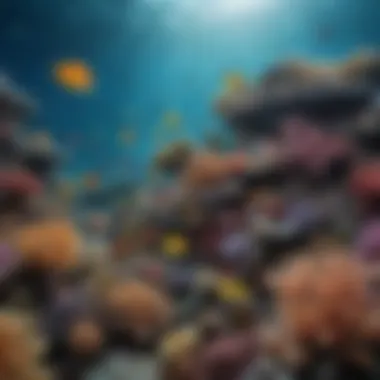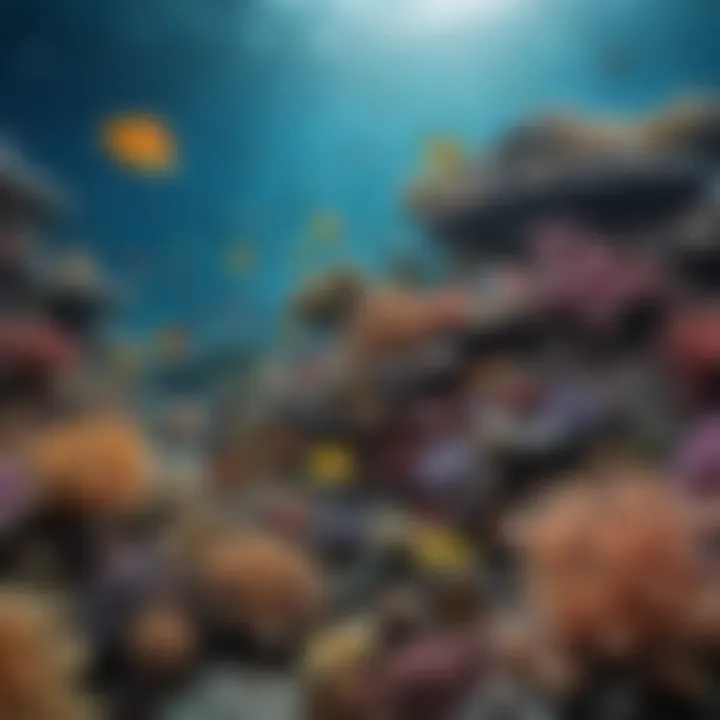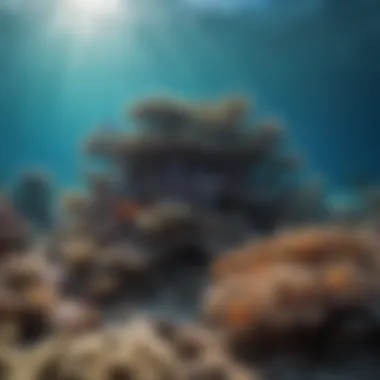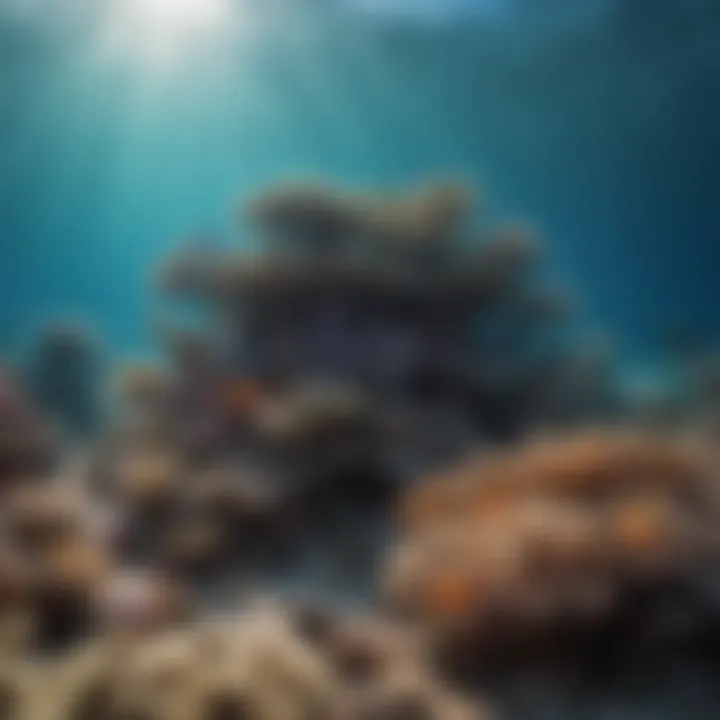The Great Barrier Reef: A Journey Through Time


Article Overview
Purpose of the Article
The Great Barrier Reef, a marvel of natural beauty and biodiversity, has undergone significant changes over the decades. It serves not only as a habitat for diverse marine life but also as an indicator of environmental health. This article aims to explore its historical context and the current state comprehensively. By examining the shifts in biodiversity, conservation efforts, and environmental impact, we can better understand the intricate relationships within this ecosystem and the challenges it faces. The goal is to elucidate the importance of informed stewardship in ensuring the reef's sustainability.
Relevance to Multiple Disciplines
Understanding the Great Barrier Reef involves various fields such as marine biology, environmental science, history, and even economics. The reef's health is directly tied to global climate patterns and local human activity. It is also a focal point for conservation strategies across the globe. Therefore, research in this area is crucial not just for scientists but also for educators, students, policymakers, and citizens alike. By recognizing the importance of the reef, various disciplines can contribute to its preservation and restoration.
Research Background
Historical Context
Since its designation as a World Heritage site in 1981, the Great Barrier Reef has encountered numerous challenges. These include coral bleaching events, largely attributed to rising sea temperatures, and the impacts of tourism and fishing. The historical perspective reveals a gradual decline in some species, while also highlighting initiatives that have emerged over the years. Knowing this context is essential for understanding current conservation efforts.
Key Concepts and Definitions
To grasp the changes that have occurred in the Great Barrier Reef, several key concepts must be understood:
- Biodiversity: Refers to the variety of life in the ecosystem, including species richness and their relationships.
- Coral Bleaching: A phenomenon where corals lose their color and vitality, often due to stress from environmental changes.
- Conservation Efforts: Initiatives aimed at protecting and restoring ecosystems, focusing on sustainable practices.
- Climate Change: Refers to long-term changes in temperature and weather patterns, significantly impacting marine environments.
As we proceed in this article, we will delve deeper into each of these aspects, providing insight into how they interconnect to tell the story of the Great Barrier Reef.
Historical Context of the Great Barrier Reef
Understanding the historical context of the Great Barrier Reef is essential for grasping its significance and current challenges. The past shapes its present, providing a backdrop against which current biodiversity, conservation efforts, and the threats it faces can be understood. The formation of the reef and its interaction with human cultures over centuries illustrate a complex relationship that has evolved.
Formation and Geological History
The Great Barrier Reef is not merely a cluster of coral; it is a geological wonder formed over millions of years. Comprising over 2,900 individual reefs, the structure spans approximately 344,400 square kilometers. Its origins date back to around 600,000 years ago, marked by fluctuating sea levels and changing climatic conditions. During the last Ice Age, the reef experienced significant alterations, with coral growth occurring during warmer periods while facing periods of decline in cooler climates.
The types of coral that make up the reef are primarily hard corals, which build calcium carbonate skeletons. Their growth is slow, often just a few centimeters annually. The geological history of the reef consists of various phases where conditions favored coral thriving or led to their near disappearance. Notably, the reef architecture plays a crucial role in providing habitats for numerous marine organisms.
Indigenous Cultures and Historical Usage
Indigenous peoples have inhabited the region surrounding the Great Barrier Reef for thousands of years. They hold a profound connection to the reef, seeing it as an integral part of their culture, spirituality, and sustenance. These communities, including the Torres Strait Islanders and Aboriginal groups, relied on the reef for food, medicine, and material resources.
Traditional fishing methods demonstrated a sustainable approach to harvesting marine life, ensuring that the ecosystem was not overwhelmed. Their understanding of the reef's cycles and species behavior was vast and sophisticated.
Over time, European colonization began to put pressure on the reef's ecological balance. Missions to exploit its resources often overlooked traditional ecological knowledge. The historical usage of the reef by Indigenous cultures highlights the need to consider these perspectives in the present-day dialogue about conservation and management practices.
"The Great Barrier Reef is not just a natural wonder; it is a critical part of Indigenous cultural heritage and identity."
"The Great Barrier Reef is not just a natural wonder; it is a critical part of Indigenous cultural heritage and identity."
Today, there is a growing recognition of the importance of integrating Indigenous perspectives into modern conservation efforts. This respects the historical usage and acknowledges that Indigenous knowledge plays a vital role in the sustainable management of the reef. The relationship with the Great Barrier Reef illustrates a broader narrative about humanity's connection to nature and the consequences of our actions over time.
Ecological Significance


The ecological significance of the Great Barrier Reef cannot be overstated. It serves not only as a vibrant marine habitat but also as a crucial component of global biodiversity. The reef contains thousands of species, contributing to the overall health of marine ecosystems and the planet. This intricate web of life provides essential services that support both environmental stability and human economies.
Biodiversity of the Reef Ecosystem
The biodiversity of the Great Barrier Reef is one of its most distinctive features. It is home to over 1,500 species of fish, more than 400 types of coral, and countless other marine organisms. This variety creates a complex ecosystem where each species plays a role. Coral polyps, for instance, are vital for building the structure of the reef, offering shelter and sustenance to various marine creatures. The diversity extends beyond just fish and coral; it includes mollusks, sea turtles, and sharks. Each species interacts within its environment, helping to maintain a balanced ecosystem.
"Healthy coral reefs are among the most productive ecosystems on Earth, making them crucial for sustaining oceanic life."
"Healthy coral reefs are among the most productive ecosystems on Earth, making them crucial for sustaining oceanic life."
The Great Barrier Reef also contributes to genetic diversity. The unique adaptations of the organisms living there can offer insights into resilience and adaptation in changing conditions. This genetic pool is important not just for ecological stability but also for potential applications in medicine and genetics.
Role within Marine Food Webs
The Great Barrier Reef plays a critical role in marine food webs. It acts as a nursery for many fish species, providing a safe habitat for young fish to develop. Predators and prey coexist in a delicate balance, where species like the clownfish thrive among anemones while larger predators, such as barracuda and groupers, maintain the population levels of their prey.
In this system, each organism's survival depends on others, illustrating the interconnectedness of marine life. The nutrient cycling facilitated by coral reefs also supports other species further out in the ocean. Furthermore, the reef aids in the carbon cycling process, which is essential in moderating climate change.
Through their structural complexity, reefs facilitate a diverse array of ecological interactions, making them a fundamental pillar for marine ecology. Overall, the ecological significance of the Great Barrier Reef underscores the urgent need for conservation and sustainable practices to protect this vital natural resource.
Environmental Changes Over Time
Understanding the environmental changes experienced by the Great Barrier Reef is critical for grasping both its past and present health. This section examines how shifts in climate and ecosystem dynamics have influenced the reef’s resilience and ecological balance. As an intricate marine ecosystem, any transformation can trigger cascading effects, impacting species diversity and habitat integrity.
Historical Trends in Coral Health
Coral health has seen considerable fluctuations over the years. Research indicates a marked decline in coral cover since the late 20th century. Surveys in the 1980s revealed coral cover at approximately 28%, which has reduced significantly due to various stressors. Key factors damaging coral health include:
- Coral bleaching: Stress from elevated sea temperatures, often linked to climate change, leads to widespread bleaching events.
- Disease outbreaks: Increased susceptibility to diseases among corals has been tied to environmental stressors.
- Overfishing: The removal of critical species disrupts the ecological balance, leading to algal overgrowth, which smothers corals.
The implications of these trends are profound. Coral reefs not only serve as a habitat for myriad marine organisms but also play a role in coastal protection and tourism. Therefore, the decline in coral health signals a potential crisis for biodiversity and human interests alike.
Temperature and Climate Variability
Temperature fluctuations have significant effects on the Great Barrier Reef. Annual average sea surface temperatures have risen, prompting alarming shifts in the coral ecosystem. Increased temperature leads to anomalies in the ecosystem, such as:
- Increased frequency and intensity of coral bleaching: Higher temperatures cause stress, leading to the expulsion of symbiotic algae (zooxanthellae). This results in coral bleaching and, if prolonged, can lead to coral death.
- Altered species distribution: As temperatures rise, marine species may migrate to cooler waters, thereby affecting biodiversity and the balance of the ecosystem.
- Ocean acidification: Higher levels of carbon dioxide result in more acidic oceans, further stressing corals and slowing their growth.
The relationship between rising temperatures and the health of the Great Barrier Reef is imperative to understand, given its ecological significance and the controversies surrounding climate change. Protecting and monitoring this delicate ecosystem is essential to address these changes and preserve its future.
Impact of Human Activities
The human impact on the Great Barrier Reef is profound and multifaceted. It encompasses various activities that have repercussions not just for the reef but also for marine biodiversity and, ultimately, people who rely on these ecosystems. Understanding the specific factors and how they intertwine with environmental health is crucial.
Tourism and Development Pressures
Tourism serves as a double-edged sword for the Great Barrier Reef. On one hand, it generates significant economic benefits, providing jobs and supporting local communities. On the other hand, increased tourist traffic leads to habitat degradation. Coral reefs are particularly vulnerable; physical contact, water pollution from boats, and trampling by divers contribute to their decline.
Recent statistics indicate that tourism accounts for billions in revenue yearly. Nevertheless, this influx has intensified demands for infrastructure, often leading to coastal development that disrupts natural habitats. As hotels and facilities expand, they can alter water flow and sedimentation patterns, adversely affecting coral health.
In 2022, the reef experienced noticeable stress during peak tourist seasons. Reports indicate coral bleaching events became more common, underscoring the relationship between human presence and coral stress levels. Efforts to promote sustainable tourism practices are essential, focusing on minimizing these adverse effects while preserving the ecological balance.
Pollution and Its Effects


Pollution constitutes one of the most severe threats to reef health. Agricultural runoff carries pesticides and fertilizers into the ocean, contributing to nutrient loading. This excess nutrients promotes algal blooms that outcompete coral for space and light. Studies predict that without significant mitigation strategies, these pollution levels could further exacerbate the already fragile state of the reef.
Furthermore, marine debris, especially plastics, poses a lethal risk to marine life. Ingesting plastic can be fatal for many species, while entanglement can lead to injuries and death. Specific data from the Australian Marine Conservation Society shows that over 100,000 marine animals are killed by marine debris each year in Australia. The implications are dire, creating an urgent need for policies aimed at reducing pollution at its source.
Fishing Practices and Biodiversity Loss
Fishing practices affect the Great Barrier Reef's ecological integrity in several ways. Overfishing disrupts food chains and can diminish fish populations, some of which play critical roles in coral health. For instance, herbivorous fish, like parrotfish, help control algal growth. When their numbers diminish, algal blooms can proliferate, leading to further coral decline.
Illegal fishing methods, such as blast fishing, further exacerbate the situation. These methods not only kill target species but also destroy coral structures, making recovery much harder. Additionally, bycatch remains an issue, as non-target marine species are often caught unintentionally, leading to declines in these populations as well.
To counteract such practices, sustainable fishing regulations are vital. Governing bodies need to enforce limits on catch sizes and protect critical habitats, ensuring that biodiversity is preserved. Without immediate action, the future of the reef's biological diversity hangs in the balance.
“Human activities, while economically beneficial, often lead to long-term ecological consequences that jeopardize the health of the Great Barrier Reef.”
“Human activities, while economically beneficial, often lead to long-term ecological consequences that jeopardize the health of the Great Barrier Reef.”
Addressing these challenges through a mix of policy intervention, community engagement, and scientific research is critical. Only through concerted efforts can the impacts of human activities be managed effectively, allowing the Great Barrier Reef to remain a valuable natural resource and ecosystem.
Conservation Efforts
Conservation efforts are vital for the sustainability of the Great Barrier Reef. This unique ecosystem faces numerous threats from climate change and human activities. Effective conservation strategies are essential not only for preserving biodiversity but also for maintaining ecological balance. Through legislation, community actions, and scientific research, numerous initiatives have been established to protect this natural wonder. All these efforts together contribute to the resilience of the reef against the ongoing environmental changes.
Legislation and Protected Areas
Legislation plays a critical role in safeguarding the Great Barrier Reef. The Marine Park Act of 1975 created the Great Barrier Reef Marine Park, which covers approximately 344,400 square kilometers. This designated area helps regulate human activities and provide protection to marine life. Specific regulations limit fishing, tourism, and other potentially harmful practices. Additionally, the Reef 2050 Long-Term Sustainability Plan outlines the goals for conservation, including improving water quality and protecting significant habitats. These legal protections ensure that the reef’s ecosystems can thrive amidst challenges.
Community Involvement in Conservation
Community involvement is a significant aspect of conservation efforts related to the Great Barrier Reef. Local communities recognize the reef's importance for tourism and fishing economies. Various organizations work alongside residents to promote conservation practices. For instance, initiatives encourage local participation in clean-up activities and educational programs. Engaging communities is crucial because it fosters a sense of ownership and responsibility towards the reef. The success of conservation strategies often depends on local knowledge and active citizen involvement.
Scientific Research and Monitoring
Scientific research and monitoring are essential for understanding the current state of the Great Barrier Reef and its response to environmental changes. Institutions conduct regular surveys to assess coral health and biodiversity. These studies help identify trends and changes in the ecosystem, enabling researchers to devise targeted conservation strategies. Moreover, monitoring programs help in understanding the effects of climate change and pollution. Data obtained through research is crucial for informing policy decisions and engineering effective management plans.
"Informed stewardship is key to the future of the Great Barrier Reef. Ongoing research and community engagement are essential components of successful conservation."
"Informed stewardship is key to the future of the Great Barrier Reef. Ongoing research and community engagement are essential components of successful conservation."
Overall, conservation efforts are integral to the survival of the Great Barrier Reef. From legal frameworks to community actions and scientific inquiries, creating a synergistic approach is necessary for protecting this invaluable marine environment.
Current State of the Reef
The current state of the Great Barrier Reef is an ongoing topic of significant concern. As one of the world’s largest coral reef systems, its condition reflects broader environmental trends and challenges. Understanding this state allows researchers and policymakers to appreciate the impact of both natural and anthropogenic factors. Central to this understanding are recent surveys and findings which highlight the health of coral populations and marine biodiversity.
Recent Surveys and Findings
Recent assessments of the reef have been conducted by scientists utilizing various methodologies, including detailed underwater surveys and advanced imaging technology. The findings suggest a complex picture. While some areas of the reef show signs of recovery after past bleaching events, other areas continue to decline due to increasing temperatures and poor water quality.
Key findings include:
- Coral Cover Variability: Surveys indicate that coral cover has experienced fluctuations in different regions of the reef. Some zones recovered partially post-bleaching, while others, particularly in the northern sectors, demonstrate significant deterioration.
- Biodiversity Assessments: Assessments show a sustained presence of diverse marine species. However, certain fish populations are declining, and this affects the overall biodiversity balance.
- Climate Impact Reports: Reports have indicated that the recurrent bleaching events are directly associated with rising sea temperatures. Research highlights the need for immediate intervention and adaptive strategies to protect these ecosystems effectively.


The ongoing monitoring is crucial for understanding the reef's health and helps direct future conservation strategies.
Resilience and Adaptation Mechanisms
The Great Barrier Reef possesses some inherent resilience and adaptation mechanisms that allow it to cope with environmental stresses. However, these mechanisms are not unlimited. Key aspects include:
- Genetic Diversity: Some coral species have demonstrated genetic traits that enable them to withstand higher temperatures. This genetic variability is vital for the adaptation of entire populations over time.
- Symbiotic Relationships: The relationship between corals and zooxanthellae algae is essential. While bleaching events occur, not all coral species lose these algae, allowing for recovery processes to begin sooner in less affected areas.
- Natural Recovery: Ecosystems generally have a remarkable ability to recover given the right conditions. Previous studies show that with reduced stressors, coral can regenerate, rebuild habitats, and improve biodiversity levels.
However, it is important to note that while the reef demonstrates some resilience, ongoing threats like climate change, pollution, and human activity significantly challenge these natural mechanisms. Without sustained efforts to mitigate these impacts, the resilience of the reef may diminish over time.
"The future of the Great Barrier Reef relies not only on understanding its current state but also on our actions today to ensure its survival for generations to come."
"The future of the Great Barrier Reef relies not only on understanding its current state but also on our actions today to ensure its survival for generations to come."
Future Prospects
Understanding the future prospects of the Great Barrier Reef is crucial for comprehending the long-term viability of this complex ecosystem. The reef faces multiple threats that require immediate action and innovative solutions. Resilience in this context refers to the reef’s capacity to recover from disturbances, which includes the ability to adapt to changing conditions and maintain its ecological functions. Managing future changes while promoting the reef's health is of utmost importance for scientists, policymakers, and conservationists.
Projected Climate Impacts
Globally, climate change has profound implications for marine ecosystems, particularly for sensitive environments like the Great Barrier Reef. As temperatures rise, coral bleaching events become more frequent, resulting in significant loss of biodiversity. Studies indicate that if current trends continue, the Great Barrier Reef could face irreversible changes within a few decades. Increasing seawater temperatures impact coral health directly, weakening these organisms, and making them more susceptible to diseases.
Furthermore, ocean acidification presents another challenge. The rise in atmospheric CO2 leads to higher levels of carbonic acid in ocean waters, altering the chemical composition. This shift affects coral calcification rates, necessary for their growth and structural integrity. Fish populations also suffer as their habitats degrade, which can influence local fisheries and dependent communities.
In summary, the projected climate impacts on the Great Barrier Reef are dire. The shift in environmental conditions underscores the need for urgent and effective climate action to preserve this invaluable ecological treasure.
Innovative Technologies in Conservation
As challenges grow, innovative technologies have emerged as a key component in conservation strategies for the Great Barrier Reef. Several techniques show promising results in monitoring and protecting coral and marine life. For instance, the use of artificial intelligence and drones allows researchers to gather real-time data on reef health. These technologies can identify coral bleaching and health metrics at unprecedented scales and speeds.
Additionally, advancements in genetic engineering present potential solutions. Scientists are exploring methods to breed resilient coral species that can withstand higher temperatures and ocean acidity. This approach may help restore degraded areas of the reef more rapidly than traditional methods.
Collaboration between technology companies and marine biologists helps integrate these innovations into practical conservation efforts. Moreover, the establishment of mobile applications that engage local communities allows for citizen science, enhancing conservation efforts through public involvement.
Ultimately, embracing innovative technologies is essential for navigating the future prospects of the Great Barrier Reef. By leveraging these advancements, we can work towards sustainable management practices that protect this vital ecosystem for generations to come.
Closure
The Great Barrier Reef stands as a testament to both the beauty and fragility of marine ecosystems. By examining its past and present, we gain crucial insights into the complex interplay between nature and humanity. This article emphasizes the awareness of our responsibilities in stewarding this natural wonder. The interconnected narrative of its historical context, ecological significance, and the impacts of human activity underscores the necessity of informed advocacy.
Summary of Key Insights
The key insights gathered throughout this article include several critical points about the Great Barrier Reef:
- Historical Significance: The geological formations shaped over millions of years have produced a diverse habitat that supports countless species.
- Biodiversity: The reef is one of the world's most biodiverse ecosystems, housing thousands of marine species. Its ecological health is vital to maintaining balance in marine food webs.
- Environmental Pressures: Climate change, pollution, and tourism present ongoing risks to the reef, demanding urgent attention.
- Conservation Initiatives: Various legislative measures and community programs aim to protect and restore the reef. These efforts are bolstered by scientific research, which also provides a clearer understanding of the reef's health.
- Future Outlook: Innovative technologies and approaches to conservation are critical in enhancing resilience against climate impacts.
The Necessity for Ongoing Advocacy
Ongoing advocacy for the Great Barrier Reef is essential in sustaining its health for future generations. Active engagement on various levels steers public attention towards conservation efforts. Considerations for advocacy include:
- Community Involvement: Increased participation from local communities ensures that initiatives are both effective and culturally relevant.
- Legislative Support: Stronger policies must be established and enforced to mitigate human impacts and support sustainable use of resources.
- Education and Awareness: Raising awareness about the reef's plight is crucial. Educational campaigns can inspire collective action.
"The survival of the Great Barrier Reef hinges on our collective actions today. Only through informed advocacy can we hope to restore its vitality and sustain its legacy."
"The survival of the Great Barrier Reef hinges on our collective actions today. Only through informed advocacy can we hope to restore its vitality and sustain its legacy."



